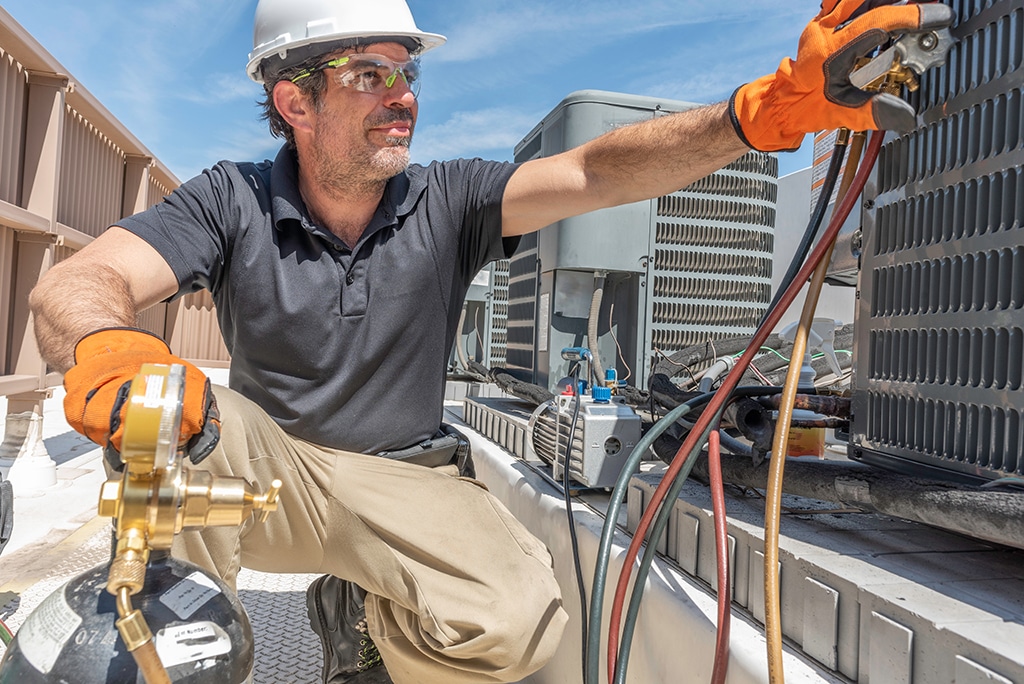
An Expert Guide To Air Conditioner Installation: AC Installation Process | Dallas, TX
Photo By David Spates at Shutterstock
Are you looking for a new air conditioning unit for your air conditioner installation in your home in Dallas, TX? An HVAC unit is one of the most elemental installations to have in your home, especially if you want to survive the fluctuating temperatures.
Installing a home air conditioning unit is not as easy as a simple DIY inspection. Air conditioner installation requires a professional HVAC expert trained and licensed to handle the job. During the air conditioner installation, the installation team must avoid cutting corners.
Every detail and process typical in the air conditioner installation process must be adhered to avoid some form of AC malfunction. Check out this air conditioner installation guide to ensure you get the best AC installation.
Step-by-Step Guide on Installing Air Conditioners
Unfortunately, this is not a DIY installation guide. Typical air conditioner installation should be conducted by a certified professional for several reasons. Once you go through every air conditioner installation step, it will be easier to understand why that is the case.
Check out how air conditioners are installed below:
1. Reaching Out to an Expert Installation Team
The Dallas, TX client/homeowner typically initiates this first step. Since it has been established that AC installations are better left for professionals, take your time to find and contact your best choice. A lot of factors go into choosing an air conditioner installation team. Read further to understand what to look for in an air conditioner installation company. Upon contacting the installation company, the experts will schedule an initial in-home estimation.
2. Planning New Installation or Replacement
The air conditioning industry has been facing constant evolution for the last few decades. Air conditioners are no longer the same now as they were 20 years ago. Most air conditioners being replaced currently are roughly 10-30 years old.
Even the current modern AC units will need replacement at some point, not only because of an exhausted lifespan but also to accommodate the new AC tech in the industry then. Modern AC units are more improved in size and efficiency.
The increase in size allows for a bigger coil, translating to improved cooling and, ultimately, AC efficiency. Therefore, due to the increased size, a modern AC unit is doubtful to fit the space of your current AC to be replaced.
This step involves planning and necessary action required to ensure a quality installation, for instance, modifying the ductwork or moving the equipment. While these may create additional costs, the benefits of a new AC installation, such as improved efficiency, will offset these extra costs. A professional installation team lays a solid plan for installing the whole AC unit without leaving any detail.
3. Gathering Relevant AC Information During the Estimation Process
During the first in-house visit, a professional estimator factors all the relevant details necessary to provide an accurate proposal. The estimator gathers all the relevant data passed to the installation team for practical planning and installation. Having sufficient relevant data pre-installation increases the chances of a timely and high-quality installation.
4. The Arrival of the Installation Team
Depending on the installation company you are dealing with, you should receive prior communication of the team’s arrival, including who to expect and their expected arrival time. Upon arrival, the project leader will review the job details with you.
You should share your concerns and any special instructions openly to avoid costly mistakes later on during this part. As you and the project leader are reviewing the details of the job, other team members may start laying out some safety measures such as floor protection and turning off the gas supply and electrical circuits.
5. Removing the Current AC Unit
The high chances are that you are installing a new AC in place of an older, less efficient model. As expected, you may lack the technical know-how to remove an existing AC unit, especially if you were not present during its installation.
The existing AC unit has a refrigerant that ought to be removed carefully before the new installation. According to the EPA, it is illegal to vent this refrigerant into the air openly. An EPA-certified installation expert uses a recovery machine and a recovery tank to remove the refrigerant from the existing AC unit safely.
Upon removing the refrigerant, the experts disconnect electrical wiring from the existing AC. Additionally, depending on the installation team you hire for the job, the team can replace the disconnect and the flexible electrical conduit (whip) during the air conditioner installation process to ensure system safety. However, if your most-likely outdated AC system lacks a disconnect box, generally, installers are required to install a new air conditioner with a new box. Once the team has securely removed all the connections, the current AC is ready to be removed from your home.
6. Prepping the Area for the New Installation
In most cases, the current location for the AC will require some advance prep work before installing the new AC. Such would include replacing the pad where the team will set the new AC on.
Additional prep work also includes leveling the ground before setting the new pad. Most experts recommend installing a composite pad instead of a concrete pad since it can crack shift unreasonably, making it hard to replace or repair.
7. Removing the Current Indoor Evaporator Coil
This coil is the other half of your AC system that sits above or underneath the furnace. It is what the other end of the refrigerant line is linked to. The coil has both cased and uncased variations. The sheet metal plenum in either application should be unlinked before installing the new coil. When access to the coil is restricted, this process tends to be complicated.
8. Removing the Current Copper Refrigerant Lines
It is typically strapped to the floor joists’ bottom. The experts remove these straps then take down the line set. Refrigerant, together with oil, travels via the lines. In traditional AC systems, the oil in the current line set varies from the oil in the new AC. These oils can’t be mixed without harming the new AC unit.
9. Installing the New Indoor Evaporator Coil
Installers have two options when putting a new evaporator coil for any new AC unit—cased and uncased. A cased coil is an ideal option since it features an insulated cabinet with removable panels that allow easy access. It is also made to sit on top of the furnace without any modifications, making repairs easy.
On the other hand, uncased coils are harder to install. However, they are just as efficient as a cased coil as long as they are correctly installed. There is no difference in life expectancy or warranty between both options.
10. Installing the New Copper Refrigerant Line Set
This set combines two individual copper lines. One of these lines is insulated and bigger than the second one. The little line is the liquid line, while the bigger one is called the suction line. They are available in several length selections ranging from 15-50 feet.
Expert installers install this line with as few turns and bend as possible. In addition, these lines are installed close to the home’s ductwork and beam. Proper protection is also necessary to avoid corrosion of these lines.
11. Setting Up the New AC Condenser
At this point, the installers have set and leveled the pad, and the electrical disconnect and refrigeration lines are ready to be wired to the new AC condenser. The installers safely uncrate the new AC unit and set it on the pad.
There may be a brief moment of inspection to ascertain the unit has no dents or any damage. One Hour Air Conditioning and Heating scrutinizes the unit when it arrives and is installed to ensure it is in good working condition.
The experts then form and fit the previously installed wire set to the appropriate service valve on the new AC. After fitting the line set to the valves, the experts braze to ensure a tight leak-free connection.
12. Filter Dryer Installation
A filter drier is a vital component in the refrigerant system. It absorbs moisture and provides physical filtration. Installing a liquid line filter drier into the unit’s refrigeration system is mandatory when installing a new AC condenser.
It is advisable to install the filter drier close to the expansion valve at the indoor coil. This protects the expansion valve and avoids exposing the filter drier to weather to speed up its rusting.
13. Installing New Low and High Voltage Wiring
Wiring must be reconnected for the AC system to operate. The installer mounts a new service disconnect box using the current power supply from the electrical panel. Local and state code requirements need the service disconnect. Additionally, all electrical connections must be made according to the National Electrical Code.
14. Installing the Condensate Drain Line
Water removed from your home during cooling flows down a plastic PVC pipe which must be connected to the evaporator coil’s primary side. The coil features a primary and secondary drain location. Primary condensate drain lines move from the indoor coil to an appropriate condensate pump or floor drain.
Where a proper floor drain is lacking in a home, a condensation pump is used. Any condensate piping or tubing should be glued or secured appropriately. A trap and overflow safety switch should be installed in the condensate system for additional protection of the equipment.
15. Startup Commissioning Process
Once the system is installed and is ready for operation, the testing process begins and runs for roughly 15-20 minutes. The testing process allows the refrigerant to flow via the system and begin the air conditioning process. A high indoor temperature is recommended to allow the AC’s components to operate fully, allowing maximum cooling potential.
Additionally, a good installer will assess the thermostat operation, system operation sequence, and several other points of concern during this process. A professional HVAC contractor ensures the air conditioner installation team properly commissions your AC before leaving your home.
16. Clean Up and Completion
This is a comparatively simple process. The team loads up and takes away all the unnecessary materials from your home. The floor protection is rolled away, and debris is swept off. The air conditioner installation team leader walks you through what was done during the installation. After the last visual inspection, there is a last review of the commissioning and thermostat operation.
This air conditioner installation process may seem tedious and overwhelming. However, in the hands of a professional air conditioner installation Dallas, TX team, the whole process should be second nature. Additionally, whether new installation or replacement, a new AC has its advantages.
Benefits of Air Conditioner Installation
Here are a few pros of installing a new AC unit:
- Increase Efficiency
A new AC comes with improved technology and an improved Seasonal Energy Efficiency Ratio (SEER). It has greater cooling capacity and can save you a lot of money when paying your utility bills.
- Increased Home Value
If you plan on reselling your home, ensure you pay attention to this vital selling point. Prospective buyers are constantly searching for homes that don’t require a lot of repairs and replacements. Therefore, with your new air conditioner installation, you can increase your bargaining chips and potentially get back the value for the AC replacement upon reselling your home.
- Improved Indoor Air Quality
Besides cooling, air conditioners play a significant role in improving indoor air quality. Consequently, this reduces allergens and contaminants in the air, helping to ensure a clean and comfortable indoor atmosphere, especially for individuals with allergies.
- Money-Saving
If you have an old and worn-out AC unit, the chances are that you spend a lot of money on repairs. By installing a new one, you only make a one-off investment that helps you reduce the extra repair costs. With a new AC, it might take a while before you start repairing severe damages.
Air Conditioner Installation Dallas, TX
Are you looking to replace your current air conditioner in Dallas, TX? At One Hour Air Conditioning and Heating of Dallas, we install high-quality air conditioners guaranteed to last long and serve you well. Whether replacing or installing a new AC for the first time, you can rely on us for fast and reliable air conditioner installation. Call us today for expert air conditioner installation in Dallas, TX.





